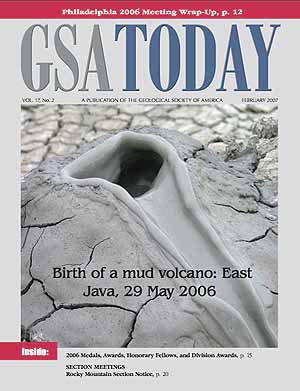
On 29 May 2006, an eruption of steam, water, and, subsequently, mud occurred in eastern Java in a location where none had been previously documented.
This “pioneer” mud eruption (the first to occur at this site) appears to have been triggered by drilling of overpressured porous and permeable limestones at depths of ~2830 m below the surface.
We propose that the borehole provided a pressure connection between the aquifers in the limestones and overpressured mud in overlying units.
As this was not protected by steel casing, the pressure induced hydraulic fracturing, and fractures propagated to the surface, where pore fluid and some entrained sediment started to erupt.
Flow rates remain high (7000–150,000 m3 per day OR 1,849,204 gallons to 22,500,000,000 gallons per day) after 173 days of continuous eruption (at the time of this writing), indicating that the aquifer volume is probably significant. A continued jet of fluid, driven by this aquifer pressure, has caused erosion and entrainment of the overpressured mud.
As a result, we predict a caldera will form around the main vent with gentle sag-like subsidence of the region covered by the mud flow and surrounding areas. The eruption demonstrates that mud volcanoes can be initiated by fracture propagation through significant thicknesses of overburden and shows that the mud and fluid need not have previously coexisted, but can be “mixed” within unlithified sedimentary strata.
See: Wikipedia | Sidoarjo mud flow
In February 2010, a group led by experts from Britain's Durham University said new clues bolstered suspicions the catastrophe was caused by human error. In the peer-reviewed journal, Marine and Petroleum Geology, Professor Richard Davies, of the Centre for Research into Earth Energy Systems (CeREES), said that drillers, looking for gas nearby, had made a series of mistakes.
They had overestimated the pressure the well could tolerate, and had not placed protective casing around a section of open well. Then, after failing to find any gas, they hauled the drill out while the hole was extremely unstable. By withdrawing the drill, they exposed the wellhole to a "kick" from pressurised water and gas from surrounding rock formations. The result was a volcano-like inflow that the drillers tried in vain to stop.
In the same Marine and Petroleum Geology journal, the group of geologists and drilling engineers refuted the allegation showing that the “kick” maximum pressure were too low to fracture the rock formation.
The well pressure analysis based on credible data showed that the well is stronger than the maximum pressure exerted on the well. This implied that the hydro fracturing hypothesis is likely to be incorrect.
See: BBC News. 2007. "Drilling blamed for Java mud leak." BBC News | Asia-Pacific. January 24.
See: Alexis Madrigal. 2010. "Mud Volcano Was Man-Made, New Evidence Confirms". Wired | Science. February 11.
Sawolo, N., E. Sutriono, B. P Istadi, and A. B Darmoyo. 2009. "The LUSI mud volcano triggering controversy: Was it caused by drilling?" Marine and Petroleum Geology 26, no. 9: 1766–1784.
See: Sawolo, N., Sutriono, E., Istadi, B., Darmoyo, A.B. (2010). "Was LUSI caused by drilling? – Authors reply to discussion". Marine & Petroleum Geology 27:1658–1675.
%8 2007-02-01 %@ 1052-5173